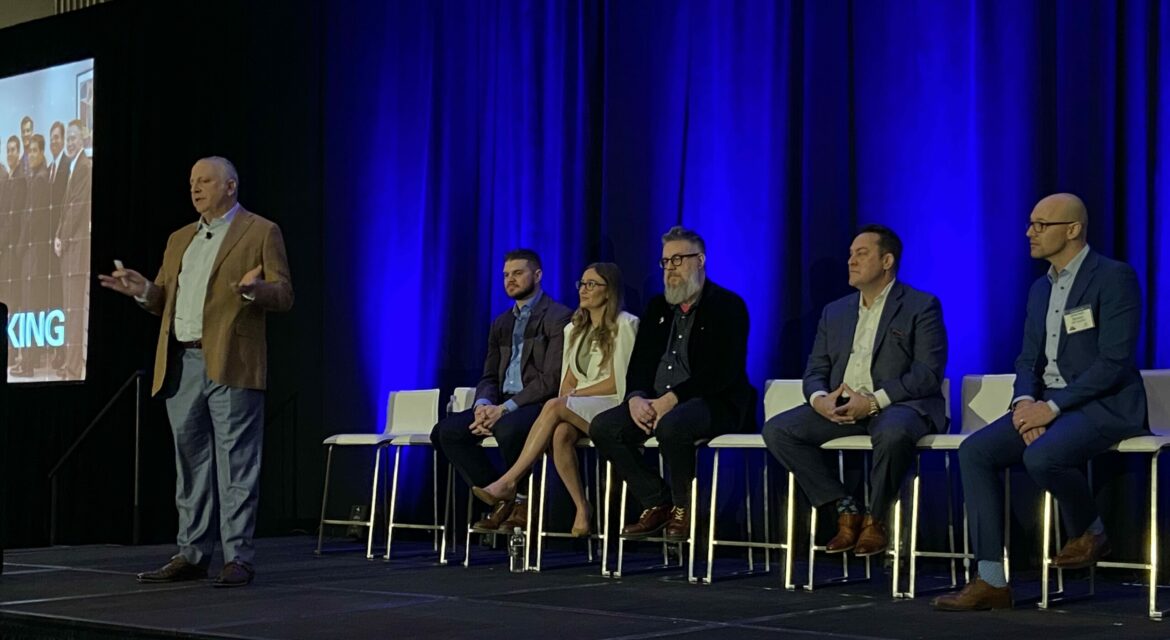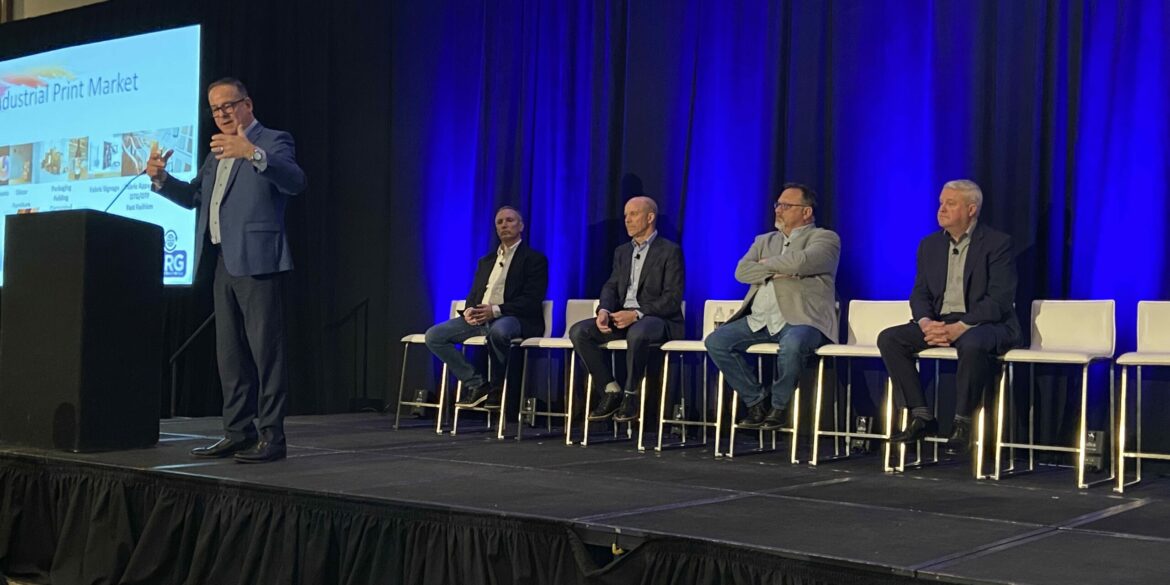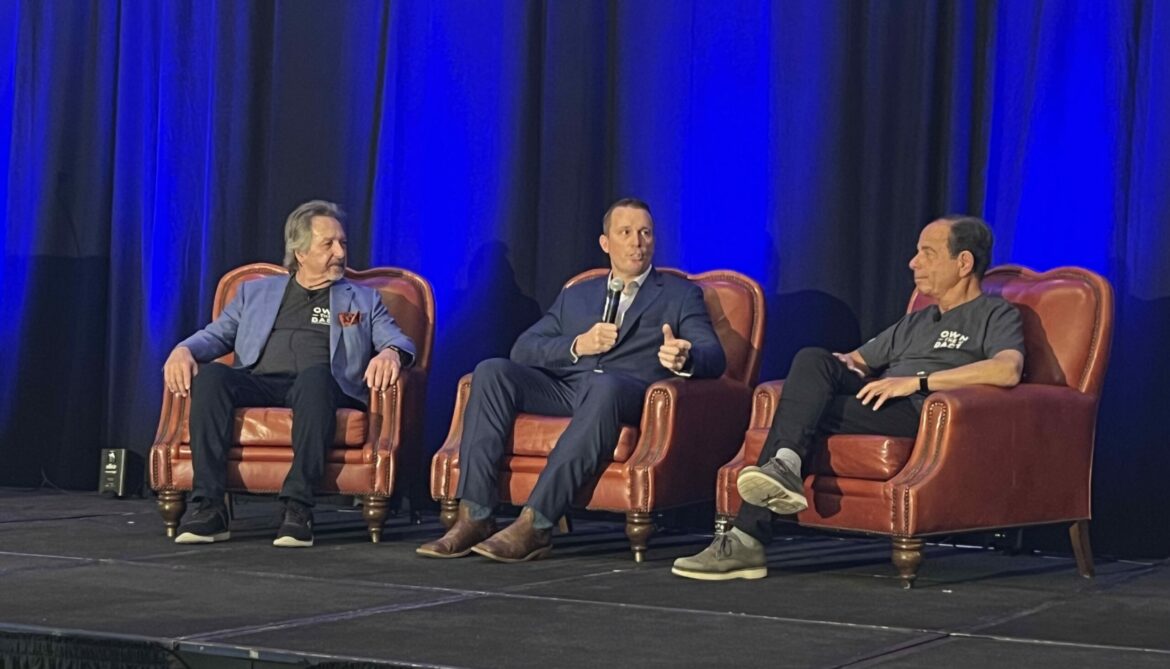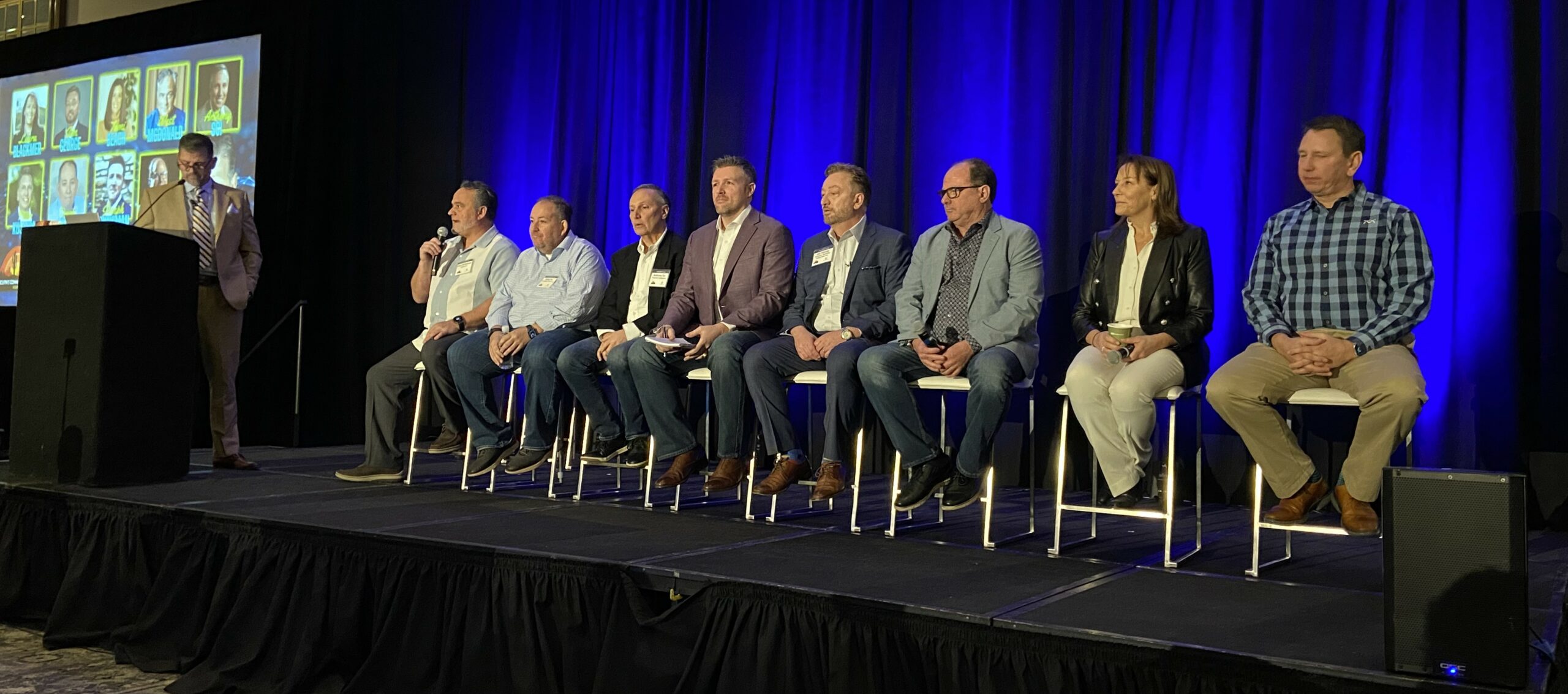Above: The “Putting AI to Work” panel at the Executive Connection Summit.
If I had to sum up the Executive Connection Summit (ECS) 2024 in one word or two letters, it would be AI. Indeed, AI (artificial intelligence for those not fond of acronyms) was the prevailing topic of multiple presentations, including some that weren’t specifically dedicated to AI. The intensive AI focus indicates how far the office technology industry has come since last year’s Executive Connection Summit when, if my memory serves me well, there was only one presentation exclusively dedicated to AI.
Of course, AI wasn’t the only focus at the Executive Connection Summit. If there’s one thing you can say about the conference is that the program is chock full of compelling content and actionable items, all of which offer insights into cutting-edge trends as well as the basics such as print, managed IT, and MPS.
A new venue, The Scottsdale Resort and Spa, allowed for added capacity to accommodate the record-setting 319 attendees. It wouldn’t be surprising to see that number increase in 2025 after all the kudos Mike Stramaglio, Hiro Ueda, and Consortium members received during and after the event.
The Executive Connection Summit is truly the place to be in January, especially if you want to network with many of the office technology’s leading executives and other office technology industry movers and shakers. More importantly, it’s an opportunity to take deep dives into the hottest trends and gain insights on new opportunities.
Frank Cucco Sets the Table at the Executive Connection Summit

Above: Frank Cucco shares his story while his executive team waits their turn to discuss the company’s various managed services initiatives.
The event kicked off in high gear with a keynote by Frank Cucco and the executive team at Impact Networking in Chicago about how managed services transformed his business. The presentation was so informative and spot on that I am using Cucco’s portion of it for The Cannata Report’s CR-Connect Dealer Tour story in our February issue. Other segments of the presentation will likely show up in future articles.
Cucco presented a crash course in not only how to build a dealership but also how to diversify, particularly in managed IT, managed cybersecurity, managed digital transformation (DX), and managed marketing. He also emphasized the need to be on the front of the curve on innovation, which is one of the reasons he and his team attend the Executive Connection Summit. “If you’re behind, there’s not as much money; it’s not as profitable,” he said. “If you’re going to get into something, you should get into it right when it’s hot.”
The “hot” example he cited was AI. “AI’s going to be the next big thing,” observed Cucco. “People should figure out how to monetize an AI product today because over the next few years, like cybersecurity, that’s going to be huge.”
For the dealers in the audience—and there was a fair amount—his message was that you always need to be evolving. “You can’t just be stuck on one product,” emphasized Cucco. “You have to see what’s coming to market, see what’s going on, and make the right adjustments, and you have to continue to diversify the product line.”
The Hey Factor at the Executive Connection Summit
The second-day keynote by John Hey of Strategic Business Associates was equally compelling and informative as Cucco’s. After sharing his story about how he ended up running a dealership that his father started in the 1940s, and then selling it, Hey shared results from Strategic Business Associates’ recent dealer survey.
The most notable revelation was that for the first time in seven years since the consulting firm has been tracking IT revenues, dealers were profitable in this segment, albeit a modest 1.3%. “There are dealers doing extremely well, but there are a lot of people at the bottom of the heap, and those who got in it are probably getting out of it because they couldn’t find the handle,” suggested Hey. “It’s too expensive.”
Other notable revelations from Hey’s keynote included:
In the early 2000s, the number of black and white copies to color copies was 10-1; today, it is 4-1. “For the last several years, we’ve been turning penny copies into five cent copies; that’s why the aftermarket revenue hasn’t dropped with the price of the click,” said Hey, who cautioned, “That’s going to level off and put more pressure on the industry to be highly efficient.”
Imaging revenues grew 14.5% from the previous year. However, Hey revealed that some dealers went backward in terms of revenue for the first time in the survey. “Those dealers are in trouble and may not survive,” he predicted.
Managed print represents 20% of the total imaging business. But, according to Hey, many dealers—small and large—aren’t offering managed print services.
“We talk about diversification, and I think it’s great, but if you haven’t maximized the opportunity in managed print, a business you know something about, why are you going off and doing IT a business you know nothing about and is very hard to do and expensive to get in?” questioned Hey. “We think managed print should be about 30% of imaging revenue, but we’re far short of that, and the majority of the dealers are far short of maximizing the opportunity in managed print.”
The Star of the Executive Connection Summit
If last year’s Executive Connection Summit started the conversation on AI, the three panels dedicated to AI and the observations about AI in other Executive Connection Summit presentations left attendees with even more to think about and act upon than last year.
One statistic reported during the panel discussion “Putting AI to Work,” moderated by Michael Cozzens of The Cozzens Group, was that 83% of companies say that AI is a top initiative in their company. Also, 79% use AI to drive revenue, profits, and marketing. Another observation from the panel was that using ChatGPT is not an AI strategy.
According to Anthony Sci of Keypoint Intelligence, the number one concern regarding AI is that it will take away jobs. “Everybody should have that concern, but leadership should talk to their people and say, ‘I’m not looking to get rid of you; what I’m looking to do is utilize your time in a way that will further grow the company,’” observed Sci. He added that this was a real turning point for Keypoint Intelligence because his people started getting behind it after hearing that.
Former MPS guru turned AI guru, West McDonald of GoWest.ai presented a primer on generative AI, dropping names like Open AI, Microsoft, Google, Anthropic, and the Chinese company Baidu. “It’s not just American companies doing this, but China and the U.S. are running neck and neck,” revealed McDonald. That said, McDonald described the big three AI players as Open AI, Anthropic, and Google.
Arguably, the most compelling comments during this panel discussion were made by Joe Brunsman of The Brunsman Group, a company that provides liability insurance for the technology industry. He spoke extensively about the cybersecurity risks posed by AI. “The risks are going to be legion,” he said. He noted that multiple government agencies and financial institutions are currently working on legislation around AI. “This is something that will materially impact every part of your organization,” he cautioned.
While some panelists argued that AI will not impact employment, Brunsman offered a contrary view. “Implementing AI is going to shrink jobs,” he predicted. “With that, you’re going to see legislation that can fundamentally change how you are using AI in your business and what the future possibilities are.”
Brunsman emphasized the importance of keeping track of the regulatory and statutory side because that will quickly have large material impacts on businesses. “If you’re not keeping up with that, oh my God, are you going to be sued into oblivion,” he said. “AI in the workplace policy will be a legal document within your business.”
More food for thought from Brunsman: “A lot of my clients ask me if I should have an AI chatbot on my website, and my first answer is absolutely not,” he said. “Here’s why; are you liable for what that AI bot says to that client? You are. Be very measured and very calculated where you are using this technology.”
The other panelists weren’t as full of doom and gloom. As McDonald noted, “I’ve been an assessment specialist for the better part of 15 years. This is just the next thing to assess to make sure we’re looking at the benefits, the regulations that need to be considered, and at the tools that will have the most impact across departments.”
“Our entire business is AI, where we focus on helping our client’s businesses be more efficient and more effective,” observed David Tan of CrushBank Technologies. According to its website, CrushBank has an artificial intelligence knowledge management system that uses machine learning and natural language processing to transform enterprise data into knowledge. Customers are primarily MSPs who are looking to improve the performance of their Help Desks.
“Whenever we talk to a prospect, one of the first questions people inevitably ask is how many people can I get rid of?” reported Tan. “And it’s always none. That’s not what AI is about. You can’t replace people with AI. If that’s how you go into this journey, you’re bound to fail. It’s about automating jobs that a machine can do as well, if not better than a human, and then elevating your people so they can do a better job on things that require a human level of understanding and human knowledge.”
Tan recommends looking at areas of improvement in one’s organization instead of looking to streamline and cut a quarter of the workforce. That sentiment was echoed by Peter Kujawa of ConnectWise, who stated that the big risk around AI was not embedding it in your product set. “Don’t use it to get rid of techs,” he said. “If you gain 20% efficiency through attrition, you’ll pick up that gain over the course of the next year, and your remaining people will be more challenged and stimulated. [AI] is an opportunity to move forward, and I would focus on the positives of it. The danger to me is if you’re not really looking at it and embracing it.”
Not Just AI at the Executive Connection Summit
Don’t get me wrong, even though AI was the star of the Executive Connection Summit, there was other compelling presentations on the agenda. For one, Sharp President & CEO Mike Marusic’s presentation “Cabinets to Cloud: Information is More Portable Than Ever,” where he made a case for OEMs and dealers alike to make their core products more relevant in a cloud environment, especially since what goes up into the cloud must still be accessible and sharable.
“We have to make them important enough to a company that when they’re figuring out their cloud strategy, they’re figuring out their print strategy. That’s a daunting challenge. That’s the key to our success.”
A challenge for dealers in this scenario, according to Marusic, is convincing a company that the dealer understands their security needs, how their business workflow operates, and that they need to control devices that are outside the walls of their building.
“That’s a huge opportunity,” said Marusic. “And when [people] come back in the building, we need to make sure they can collaborate the way people collaborate today. I hope we figure out as an industry how we make it ours, how we control it, how we take what used to be a click and make money off of that every time they communicate or every time they leverage information or store information. When you make that the goal, the office is your empire, and all devices are your empire.”

Above: Frank Mallozzi describes the significant industrial print opportunity.
Another highlight was former EFI executive turned consultant Frank Mallozzi’s panel Beyond the Page, which focused on industrial print. Attendees learned that profit margins are strong on the systems, service, and supplies and that workflows are similar to what dealers are familiar with from traditional print products. More importantly, all offer strong recurring revenue streams.
Hire More Vets

Above: Dakota Meyer describes his philosophy of owning the dash to an attentive Mike Stramaglio and Bob Goldberg of BTA.
If you know Mike Stramaglio, you know he is passionate about veterans’ issues. Two sessions were devoted to veterans, including an inspiring fireside chat with Dakota Meyer, a Marine who shared his journey into the military and the battle that led to his receiving the Medal of Honor. Meyer also advocated for the hiring of veterans, another passion of Stramaglio.
A second panel was exclusively focused on bringing more veterans into the office technology industry. Outside of that, the most compelling case for hiring veterans was made by Frank Cucco during his opening keynote presentation when he reported that this was one of the action items he took home from last year’s Executive Connection Summit. In 2023, Impact Networking hired 150 veterans.
That’s Not All Folks
I’ve only scratched the surface of what took place at the Executive Connection Summit. There was so much more such as a ConnectWise panel on AI that introduced the concept of hyperautomation, GreatAmerica Financial Services’ discussion of embedded technology, and another AI-inspired panel moderated by Andy Slawetsky of Industry Analysts with Dino Pagliarello and Laura Blackmer of Konica Minolta.
The Cannata Report was there for every presentation, and I plan to share more insights from the event with you in upcoming articles or as inspiration for future articles.





